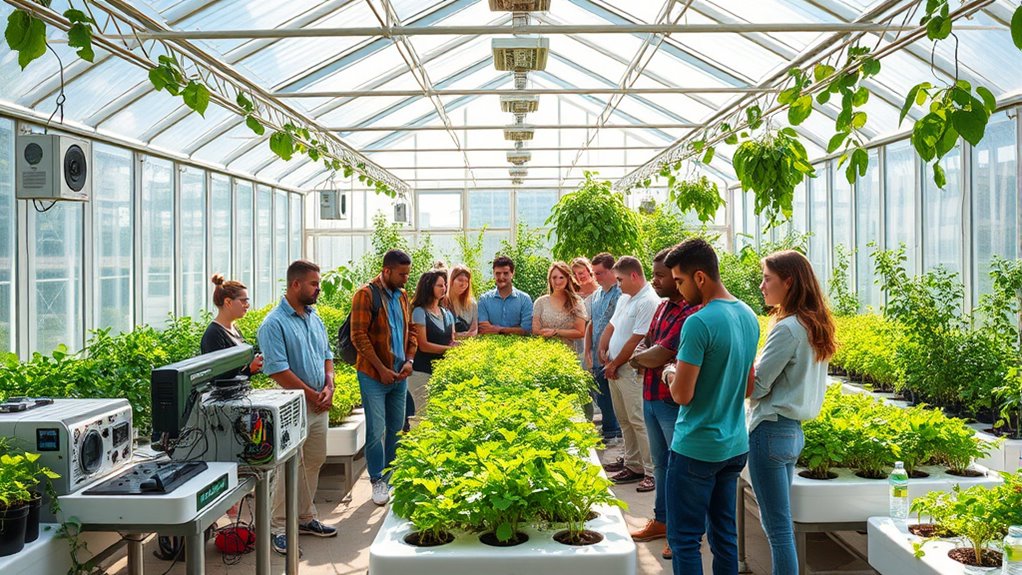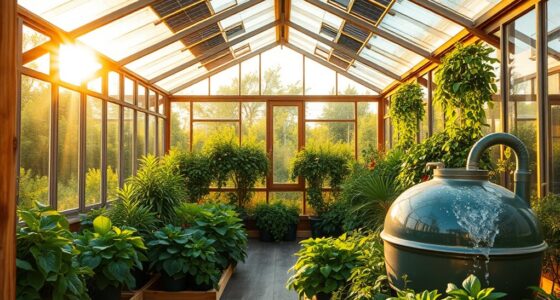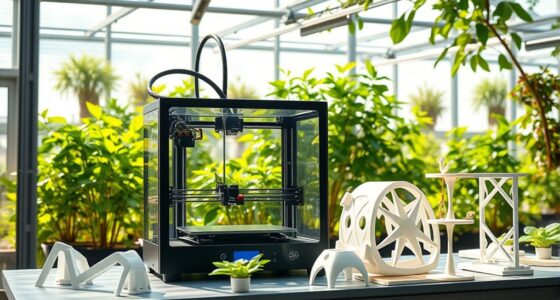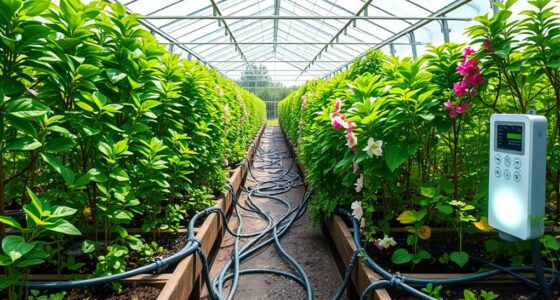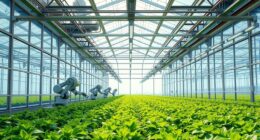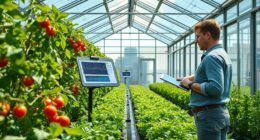Open-source innovations are changing how you approach sustainable greenhouses by giving you access to customizable, affordable tech solutions. These community-driven projects help you develop smarter systems like energy-efficient climate controls and resource monitors. They also encourage local participation, creating skills, jobs, and stronger food security. Plus, open-source designs enable scalable setups tailored to your resources and needs. Keep exploring to discover how you can harness collaborative tools for greener, more resilient farming practices.
Key Takeaways
- Open-source projects enable customizable, low-cost greenhouse designs tailored to specific climates and resource constraints.
- Collaborative tech fosters knowledge sharing, innovation, and continuous improvement in sustainable greenhouse systems.
- Community-driven initiatives promote local involvement, skill development, and job creation in sustainable agriculture.
- Open-source blueprints and software reduce dependence on proprietary solutions, enhancing scalability and accessibility.
- Collective efforts advance environmentally friendly farming practices, increasing resilience and food security for underserved communities.
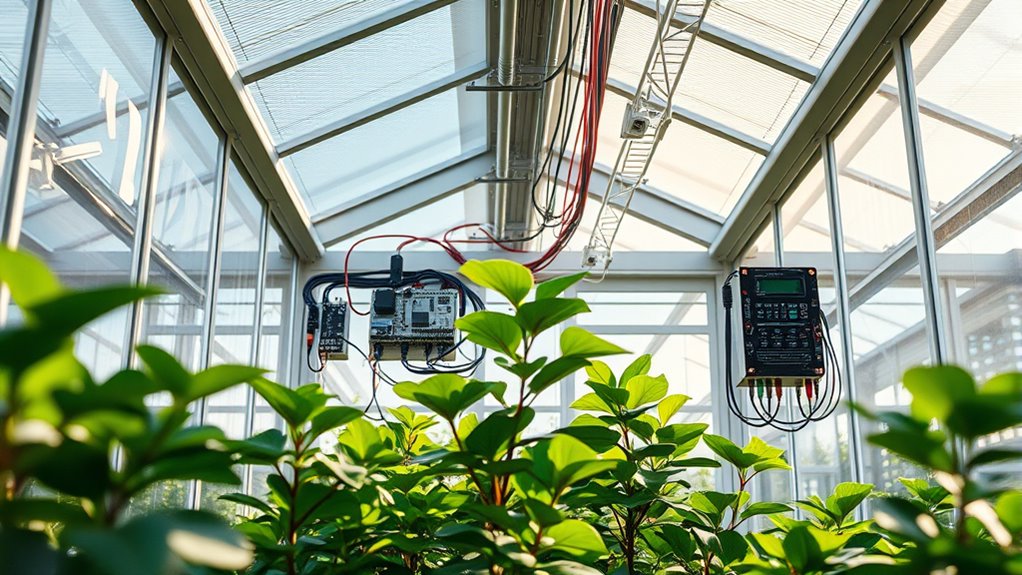
Have you ever wondered how open-source innovations are transforming technology? These collaborative efforts are not only revolutionizing industries but also opening new doors for sustainable farming and community development. When it comes to greenhouses, open-source projects enable farmers, engineers, and enthusiasts to share knowledge, customize systems, and improve efficiency without the heavy costs often associated with proprietary solutions. This collective approach makes sustainable farming more accessible, especially for small-scale farmers or those in underserved communities, empowering them to grow food more responsibly and with fewer environmental impacts.
By leveraging open-source technologies, you gain the ability to design and build greenhouses that are tailored to specific climate conditions and resource availability. Instead of relying on expensive commercial systems, you can tap into a global community of developers and farmers who contribute innovative ideas, open-source hardware, and software improvements. This collaborative environment fosters continuous innovation, allowing for smarter irrigation systems, energy-efficient climate controls, and sensors that monitor plant health—all of which optimize resource use and promote sustainability. As a result, open-source greenhouse projects help reduce waste, lower energy consumption, and decrease reliance on chemical inputs, aligning with the goals of sustainable farming.
Open-source greenhouse tech enables tailored, sustainable farming through community-driven innovation and resource-efficient systems.
Beyond the ecological benefits, open-source greenhouses also promote community development. These projects often encourage local participation, where community members can learn new skills, share their experiences, and contribute to collective success. You might find yourself involved in workshops or collaborative builds, fostering a sense of ownership and pride in the project. This collective effort strengthens local networks, creates jobs, and promotes food security by enabling communities to grow their own produce independently. It’s about more than just technology—it’s about building resilient, self-sufficient communities that prioritize environmental health and social well-being.
Open-source innovations make it easier for communities to adapt and scale greenhouses efficiently. Whether you’re a hobbyist or a small farmer, access to open-source blueprints and software means you aren’t locked into expensive vendor contracts. Instead, you can modify and expand your greenhouse systems based on your specific needs, encouraging a culture of continuous improvement. As more people participate, knowledge spreads faster, and solutions become more refined, ultimately fostering a more sustainable approach to agriculture that benefits both the environment and local economies.
In essence, open-source innovations empower you to be part of a larger movement toward sustainable farming and community development. They break down barriers, foster collaboration, and enable smarter, more environmentally friendly ways to grow food. By embracing this collaborative spirit, you contribute to a future where greenhouses are not only more efficient but also more inclusive, resilient, and aligned with the needs of our planet and its people.
Frequently Asked Questions
How Do Open-Source Greenhouse Designs Compare in Cost-Effectiveness?
You’ll find that open-source greenhouse designs often cost less overall because they promote cost savings through shared resources and community-driven improvements. Plus, the design flexibility allows you to customize setups to suit your specific needs, avoiding expensive, one-size-fits-all solutions. This collaborative approach enables you to adapt and optimize your greenhouse efficiently, making open-source designs a more economical choice for sustainable gardening and farming projects.
What Are the Security Concerns With Open-Source Greenhouse Technologies?
Imagine opening Pandora’s box—your open-source greenhouse tech faces cybersecurity vulnerabilities, risking unauthorized access. You might worry about data privacy breaches, which could compromise sensitive environmental data or control systems. While open-source designs foster collaboration and innovation, they can also expose weaknesses if not properly secured. To protect your greenhouses, you need strong cybersecurity measures and vigilant monitoring, ensuring your sustainable efforts remain safe from digital threats.
How Can Small-Scale Farmers Access Open-Source Greenhouse Plans?
You can access open-source greenhouse plans by participating in DIY kits and community workshops that focus on sustainable farming. These resources often provide detailed blueprints and hands-on training, making it easier for small-scale farmers like you to build and customize greenhouses. By tapping into local or online groups, you gain practical knowledge and support, empowering you to implement eco-friendly solutions without hefty costs or technical barriers.
Are There Successful Case Studies of Open-Source Greenhouse Implementations?
Sure, because everyone loves a good fairy tale, right? There are indeed successful case studies where community collaborations and technological innovations transformed small farms. These greenhouses thrive because farmers share open-source plans, cutting costs and boosting yields. Such real-world examples prove that when you embrace collaborative tech, sustainable greenhouses aren’t just dreams—they’re thriving realities, showing how innovation fuels growth and community spirit in agriculture.
What Licensing Models Govern Open-Source Greenhouse Technology Sharing?
You should know that open-source greenhouse technology typically falls under licensing agreements that promote sharing and collaboration. These licenses, like Creative Commons or GPL, balance protecting intellectual property rights with permitting others to modify and distribute the tech. By understanding these licensing models, you can ensure you’re legally sharing innovations, fostering sustainable practices, and contributing to a collaborative community focused on green solutions.
Conclusion
By embracing open-source innovations, you can transform greenhouse technology and promote sustainability. Did you know that over 60% of new agricultural tools now incorporate open-source designs? This collaborative approach accelerates development, reduces costs, and makes greenhouses more eco-friendly. So, as you explore these innovations, remember that your participation helps create smarter, greener solutions—making a real difference for our planet’s future. Join the movement and be part of sustainable change today.
